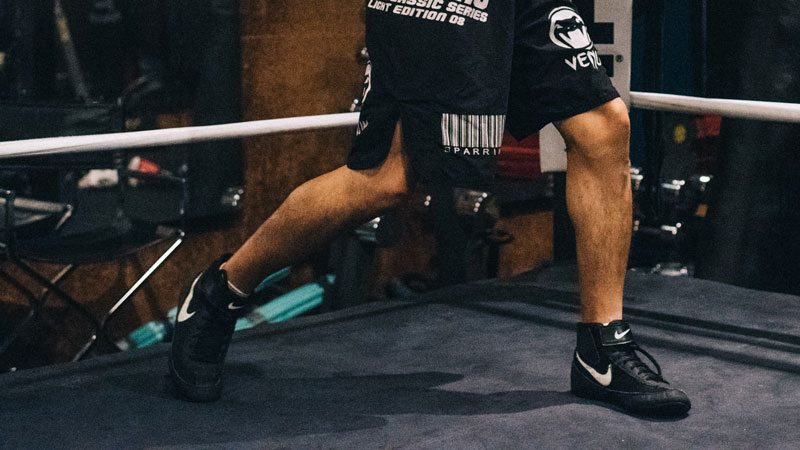
The most basic boxing balance and footwork drills. Essential for all fighters!
Are you a beginner boxer trying to develop your fighting footwork, or an advanced fighter just trying to your footwork super rock-solid?
Here are a few absolutely fundamental drills that I think all fighters must know! Very simple, but can actually be challenging even for experienced fighters or really athletic folks. 🙂
DRILL #1 – blocking from static position
So simple and yet so amusingly challenging for even the more athletic and “experienced” fighters. It tests your #1 most basic footwork ability, which is not your ability to move but rather “the ability to NOT move”. Before you can even punch, block, or move with balance/control, you need to have a rock-solid stance! This little drill reveals whether or not you know how to stand properly.
How to practice static-blocking:
- Stand in your boxing stance. Relaxed, calm, breathing, fists unclenched.
- Have someone throw one punch at a time. (Start with an open-hand slap to your shoulders from both sides, and then lower to the elbows.) You’d be surprised how many people tip over off balance at this point.
- Then have them throw more realistic punches. Straight jabs/crosses, hooks, uppercuts, both to the head and body and you have to block all of them.
- Don’t go crazy…it’s not a defense drill. Throw these punches one at a time. Start with one every 5 seconds. Once you get comfortable, can be one every 3 seconds and you can even reposition and reset yourself as if you’re in a live fight.
- Once you’re comfortable to just blocking from your neutral stance, do the harder version: throw any punch but hold that arm out and have your assistant slap you anywhere on your body. (Shoulder, arm, etc).
- The goal is test your balance, not your defense! Have them throw at obvious places and fully telegraphing so you can where the shot is going.
Tips for standing and static-blocking better:
- Have your weight at 55:45 weight distribution between the front and back leg.
- Legs almost straight but knees relaxed. Think to be tall, but your head/chin down. Don’t crouch.
- Don’t stand so sideways. Your back foot should have a clear line of sight to your opponent’s head.
- Use an explosive push-back in both your breath (exhale sharply when blocking) and your body (tensing a tiny bit during impact) to repel the punch and prevent it from pushing you over.
- The trick to pushing back is to transfer the punch impact to your legs and floor, don’t push back from your upper body (since that would only make you lose balance even more).
Maybe some of you think you’ve had fantastic footwork all this time and don’t even need this drill. But actually, you DON’T have good footwork. You just have good athleticism and move well, but still lacking balance. Poor stability means you won’t be able to punch to your fullest potential, also requiring more energy to move, and also not able to block and move with maximum balance and agility.
DRILL #2 – jumping rope
So you finally got good at NOT moving? Ok, ok…now is time to actually start moving. And this is a super simple but probably the best boxing footwork drill of all for beginners. I’ve already said it a thousand times before and also made an article on it (why jumping rope is the #1 boxing footwork drill for beginners).
It develops your efficiency more than anything and without developing a basic level of efficiency, coordination, and rhythm within your body, you won’t be a very effective boxer at all. Literally every movement you make will take more energy and make you so tired that you won’t get to do as much in the ring.
How to jump rope:
- Get a jump rope
- Jump for 15 minutes straight (no breaks)
- Getting tired or keep tripping? It doesn’t matter, just reset and keep going until the time is up.
- Do this everyday, until it’s super super easy.
Tips for the skipping rope:
- Breathe out of your nose.
- Don’t worry about being good. Just focus on keeping your body moving (and not taking breaks).
- Use a proper-length rope and don’t jump too high.
DRILL #3 – step-drag (in INCHES)
Ahhhh, the classic step-drag. It’s the basic footwork drill that all coaches make beginners do to keep their feet on the ground. The nuance here is that I want you to focus only on moving a few inches at a time. Think like 2-3 inches.
How to practice the step-drag:
- Step with one foot (a few inches) in any direction, and then reset the other foot quickly to recover your boxing stance on the new position.
- Reach with your toes with the stepping foot. And push off with your toes on the dragging foot. (The common problem is when fighters rock back off their front heel when going back.)
- Be quick but RELAXED (not too explosive or too stiff).
- Resist the urge to step far, that’s not the point of this drill!
- Don’t jump! Keep your weight down.
Tips for the micro step-drag:
- I have different visualizations on each step I make. Sometimes it’s a micro-reach (with the stepping foot), other times it’s like a micro-push (with the drag foot), and other times I think of it like a micro-freefall with both feet moving at the same time. Sometimes I also feel like it’s a micro-jump but with only my upper body and not my lower body. Mix it up!
- Can throw some punches to help you find some fluidity between punches and footwork. It’s possible to do both at the same time.
- Don’t drag your feet too hard. It’s about keeping your hips down and not popped up in the air.
- Try throwing a quick little punch (sharply) after some of your movements. This will really test if you were really able to get to the new position quickly.
- Stay relaxed. Don’t think speed or explosive at all! Think smooth sometimes, and slightly fidgety other times.
DRILL #4 – small pivots
I have yet another simplified drill for you…this time, just making small pivots. You’re going to practice doing small pivots, swinging the back leg in both directions (clockwise and counter-clockwise). And you’re going to do it SLOWER, and VERY RELAXED!
Again, this is one of those simple drills that beginners can’t help but turn it into something else. You show them a simple pivot one minute, and next thing you know they’re jumping around and trying to do fancy stance-switches. Cut that out and do it right, so you develop the right skill with this!
How to practice small-pivots:
- Stand relaxed and start with really small pivots (only 10-15 degrees) at a time.
- Mix it up with the step-drags. Move linear sometimes, then throw in a pivot.
- Here and there, you throw in a bigger pivot…like 45-90 degrees.
- Practice doing it super relaxed and arriving into a perfect solid stance.
- Now practice throw punches RIGHT after you pivot. This is where that relaxed stability really matters. Many fighters try to move too quick or too far, and they end up taking too long to re-stabilize for throwing punches.
Tips for the micro-pivot:
- Sometimes I think of pivots as a PIVOT, but other times I think of them as just a QUICK STEP with my back foot. Like my back foot simply “steps” straight over instead of “pivoting” (and swinging) over. You get it?
- Don’t try to swing the whole upper body. Instead, maybe a small turn of the shoulders is all you need. For some pivots, you don’t even have to move the upper body.
- Don’t lift your head or chin when you pivot. Try to end up in the same neutral position instead of more tilted or weight shifted to the back foot.
- Don’t try to pivot so much! Think SMALL PIVOT, ok?! Yes, the smaller..the better! (Just enough to be a pivot, and no more than that.)
DRILL #5 – relaxed shadowboxing (making relaxed direction changes)
Ok, now time to combine everything you just learned.
- Solid stance (and being able to block without getting pushed back off balance).
- Jump rope coordination and endurance.
- Small drag-steps.
- Small Pivots.
Do it all while shadowboxing. A couple quick foot movements here and there. Mix in some punches. Mix in some head movements.
PRACTICE FLOW-TRANSITIONS
- Try to flow from one movement to the next.
- Using the momentum of your punches, head movement, and footwork to transition back and forth between all of them.
- Make it all fluid! AND SMOOTH!
- This is to develop your smooth fighting style; lots of finesse and calmness.
PRACTICE STOP-TRANSITIONS
- Then also try making a clear separate movements. Basically adding a very quick “stop” after every movement.
- Like a step, then a very slightly momentary pause, and then a punch.
- Basically like a fidget/herky-jerky style BUT CLEAN!
- This is to develop your quick-feint fighting style; lots of suddenness and quick directional changes.
What makes a good boxing footwork drill?
The best boxing footwork drills develop agility, finesse and stability,
not speed, range and explosiveness.
I think there has been great misunderstanding that boxing footwork needs to be fast and explosive, and cover lots of ground. I keep seeing more and more flashy footwork drills being shared on the internet now. Facebook and Instagram are full of gimmicky footwork drills that only teach you how to lose your balance faster. Gone are the nuances on finesse, and smooth agility. Too much focus on erratic and “hard” movements, and drills that appear exciting.
Basketball, football, and soccer are sports that cover lots of ground.
Boxing is a sport with a 20-foot ring.
The differences go beyond that as well. Like those other sports being able to rotate out players and getting rest time whereas in boxing, you better not gas out before your opponent. Ultimately, my point is that their footwork strategy is very different from boxing. In boxing, yes…you have to move but it’s not a game to see who can cover more ground. It’s a game of who can move just enough to be evasive, but still be connected to the ground to deliver hard shots.
The #1 footwork problem with beginner fighters nowadays:
no balance and no endurance.
Beginners move too much and get tired fast. And it has a lot to do with their mentality! They think “more movement” is better! And they’re actually half right.
The best footwork mentality in boxing:
to move a lot within a small amount of space.
This way, with only 4-5 feet of open canvas around me…I can make 10-20 different attacks and evasive maneuvers!
But what about beginners? Hahaha, you give them only 4-5 feet of space…
- And right away, they jump all the way back onto the ropes with just one step.
- And then wiggle around stuck in the corner (taking many punches).
- Then they run out of the corner.
- But now they’re too far from their opponent. So they have to jump back in.
- But since their opponent is on the attack, they crash into their opponent and swinging wild.
- Two fighters standing too close to each other, one will fall back off-balance or even both.
- And now they’re tired already.
Please, everyone….make lots of movements, but using as little movement as possible. You get it?! [Of course, you do. That’s why I love talking to you guys.]







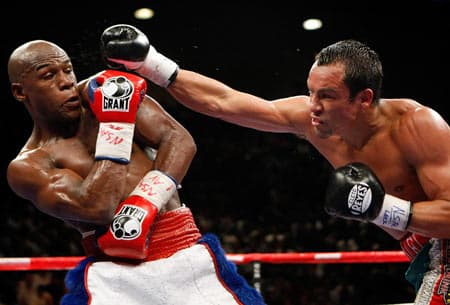
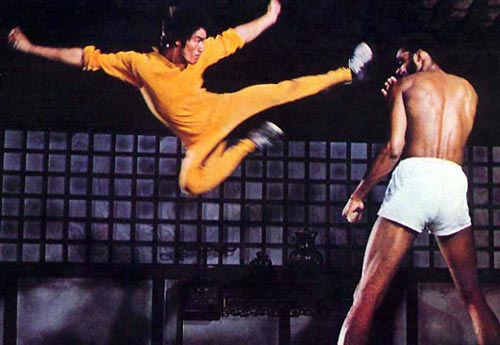
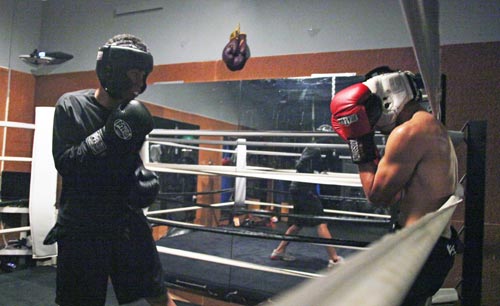
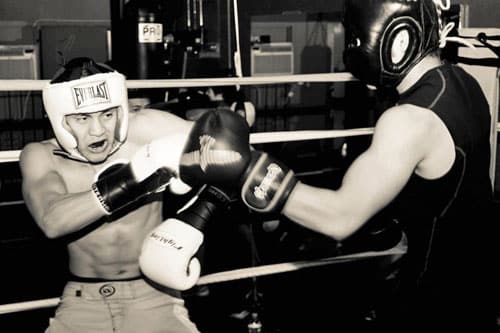
Great article and videos Johnny. You identify important issues that are difficult to see at first glance but are imperative to being a great boxer. The example you used when stepping in with the jab is a real eye opener. I actually practiced this with a friend and when I asked him to freeze after the jab he tipped forward haha. Really helps put things in perspective where your weaknesses lie. I love how you explain the importance of being balanced at all stages. It really is a game changer when you can fire a combo and have confidence that you are rigid enough to stay in place and not compromise your stance. Makes it much easier to counter back or evade. Lastly, great explanation on the pivot and its uses. I currently use the pivot when retreating to fire an uppercut when the opponent tries to bull rush me, but I’m sill trying to find a way to make it work for me on offense, so experimenting with smaller turns seems like a solid idea. Always looking forward to your wisdom Johnny. Keep dropping those knowledge bombs!
I’m really glad it resonated with you, Paul. I love moving so much less and less. Back when I was new, I loved the feeling of explosiveness. Now, I love the feeling of always finding more spaces too move to while my opponent is the one who feels trapped/limited.
Came back to boxing almost 4 months ago and ever since I found out about your website and channel I improved so much! Definitely needed this as well since I’ve been trying to practice my footwork for a while now. Thank you for your amazing knowledge man 🙂
Send me tips to become a better boxer. Are there books?
I really like this article, i am a boxing trainer and i exactly proved this page. If you need any help let me know https://www.boxingdowntowntoronto.com/ this is my internet page
Hello Johnny, excellent break down of beginner footwork. I have been going through few books and boxing articles, and I have come across various stances and here is a doubt for you.
I read Jack Dempsey’s Championship Fighting(it has some really good tips) and I read that a fighter should point his front foot towards his/her opponent, and I have found out that it helps keep balance for both punching and defending.
And then in many modern day articles I have studied, they say to keep the front foot angled at 45 degrees. It is also helpful for blocking punches and provide smaller target for opponents.
It is confusing for me, shall I follow Jack’s advice or it is for advanced levels or it just won’t work in this times anymore like it will make you vulnerable to modern day athlete?
Jack’s advice is more correct for me. When you turn your front foot too sideways, it makes your whole body too sideways and many issues with that. (Shorter range on back hand, bad balance when blocking hooks, etc.)
Love your work mate, been trying to work on footwork/balance for months now, really enjoyed your 10 advanced secrets also. Great detail
Shoutout from fellow vietnamese in Oz!
Nice to have you, Khanh!
Awesome article! I like how you mentioned how important it is to find your balance & how practicing flow transitions creates good flow & smooth technique. Footwork is so important in boxing! I actually wrote an article myself on my own martial arts blog. Here’s the link to the blog article I wrote about boxing footwork https://mixedmartialarts.life/boxing/5-reasons-why-its-important-to-learn-about-footwork-first-in-boxing/ . Please give it a read when you have the chance.